使用 DataTransformer 和 Pipeline 进行数据(预)处理¶
在本 notebook 中,我们将演示如何使用 darts 执行一些常见的预处理任务
作为示例,我们将使用 Monthly Milk Production 数据集。
DataTransformer 抽象¶
DataTransformer 旨在提供一种处理 TimeSeries 变换的统一方式
所有转换器都实现了
transform()方法。该方法接受一个TimeSeries或一个TimeSeries序列作为输入,应用变换并将其作为新的TimeSeries/TimeSeries序列返回。inverse_transform()由存在逆变换函数的转换器实现。它的工作方式与transform()类似fit()允许转换器在调用transform()或inverse_transform()之前先从时间序列中提取一些信息
设置示例¶
[1]:
# fix python path if working locally
from utils import fix_pythonpath_if_working_locally
fix_pythonpath_if_working_locally()
%load_ext autoreload
%autoreload 2
%matplotlib inline
[2]:
import warnings
import matplotlib.pyplot as plt
import pandas as pd
from darts.dataprocessing import Pipeline
from darts.dataprocessing.transformers import (
InvertibleMapper,
Mapper,
MissingValuesFiller,
Scaler,
)
from darts.datasets import MonthlyMilkDataset, MonthlyMilkIncompleteDataset
from darts.metrics import mape
from darts.models import ExponentialSmoothing
from darts.utils.timeseries_generation import linear_timeseries
warnings.filterwarnings("ignore")
import logging
logging.disable(logging.CRITICAL)
读取数据并创建时间序列¶
[3]:
series = MonthlyMilkDataset().load()
print(series)
series.plot()
<TimeSeries (DataArray) (Month: 168, component: 1, sample: 1)>
array([[[589.]],
[[561.]],
[[640.]],
[[656.]],
[[727.]],
[[697.]],
[[640.]],
[[599.]],
[[568.]],
[[577.]],
...
[[892.]],
[[903.]],
[[966.]],
[[937.]],
[[896.]],
[[858.]],
[[817.]],
[[827.]],
[[797.]],
[[843.]]])
Coordinates:
* Month (Month) datetime64[ns] 1962-01-01 1962-02-01 ... 1975-12-01
* component (component) object 'Pounds per cow'
Dimensions without coordinates: sample
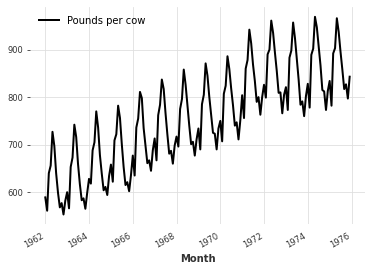
使用转换器:使用 Scaler 重缩放时间序列。¶
某些应用可能要求您的数据点介于 0 和 1 之间(例如,将时间序列馈送到基于神经网络的预测模型)。这很容易通过使用默认的 Scaler 实现,它是 sklearn.preprocessing.MinMaxScaler(feature_range=(0, 1)) 的封装。
[4]:
scaler = Scaler()
rescaled = scaler.fit_transform(series)
print(rescaled)
<TimeSeries (DataArray) (Month: 168, component: 1, sample: 1)>
array([[[0.08653846]],
[[0.01923077]],
[[0.20913462]],
[[0.24759615]],
[[0.41826923]],
[[0.34615385]],
[[0.20913462]],
[[0.11057692]],
[[0.03605769]],
[[0.05769231]],
...
[[0.81490385]],
[[0.84134615]],
[[0.99278846]],
[[0.92307692]],
[[0.82451923]],
[[0.73317308]],
[[0.63461538]],
[[0.65865385]],
[[0.58653846]],
[[0.69711538]]])
Coordinates:
* Month (Month) datetime64[ns] 1962-01-01 1962-02-01 ... 1975-12-01
* component (component) <U1 '0'
Dimensions without coordinates: sample
这种缩放也可以通过调用 inverse_transform() 轻松反转
[5]:
back = scaler.inverse_transform(rescaled)
print(back)
<TimeSeries (DataArray) (Month: 168, component: 1, sample: 1)>
array([[[589.]],
[[561.]],
[[640.]],
[[656.]],
[[727.]],
[[697.]],
[[640.]],
[[599.]],
[[568.]],
[[577.]],
...
[[892.]],
[[903.]],
[[966.]],
[[937.]],
[[896.]],
[[858.]],
[[817.]],
[[827.]],
[[797.]],
[[843.]]])
Coordinates:
* Month (Month) datetime64[ns] 1962-01-01 1962-02-01 ... 1975-12-01
* component (component) <U1 '0'
Dimensions without coordinates: sample
请注意,Scaler 也允许在其构造函数中指定其他缩放器,只要它们在 TimeSeries 上实现了 fit()、transform() 和 inverse_transform() 方法(通常是 scikit-learn 中的缩放器)
另一个例子:MissingValuesFiller¶
让我们看看如何处理数据集中的缺失值。
[6]:
incomplete_series = MonthlyMilkIncompleteDataset().load()
incomplete_series.plot()
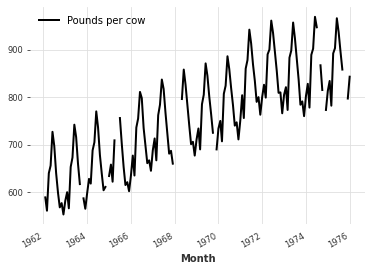
[7]:
filler = MissingValuesFiller()
filled = filler.transform(incomplete_series, method="quadratic")
filled.plot()
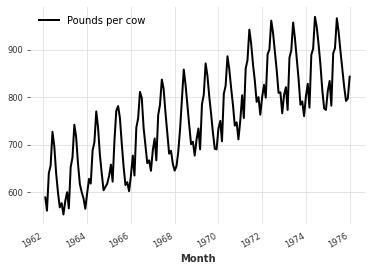
由于 MissingValuesFiller 默认封装了 pd.interpolate,因此我们在调用 transform() 时也可以向 pd.interpolate() 函数提供参数
[8]:
filled = filler.transform(incomplete_series, method="quadratic")
filled.plot()
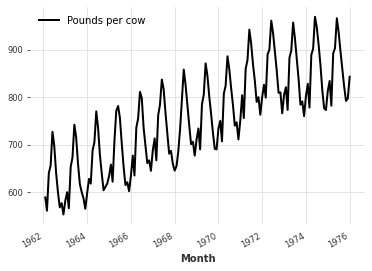
Mapper 和 InvertibleMapper:一种特殊的转换器¶
有时您可能想对数据执行一个简单的 map() 函数。这也可以使用数据转换器来完成。Mapper 接受一个函数并在调用 transform() 时将其逐元素应用于数据。
InvertibleMapper 还允许在创建时指定一个逆函数(如果存在),并提供 inverse_transform() 方法。
[9]:
lin_series = linear_timeseries(start_value=0, end_value=2, length=10)
squarer = Mapper(lambda x: x**2)
squared = squarer.transform(lin_series)
lin_series.plot(label="original")
squared.plot(label="squared")
plt.legend()
[9]:
<matplotlib.legend.Legend at 0x7ff5e3826c10>
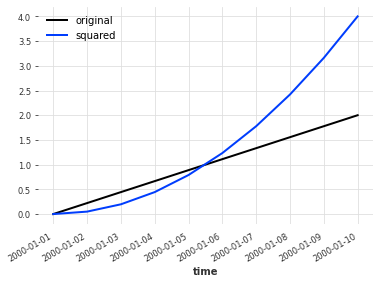
更复杂(且有用)的变换¶
在之前使用的 Monthly Milk Production 数据集中,月份之间的一些差异来自于某些月份包含的天数多于其他月份,导致这些月份的牛奶产量更大。这使得时间序列更复杂,因此更难预测。
[10]:
training, validation = series.split_before(pd.Timestamp("1973-01-01"))
model = ExponentialSmoothing()
model.fit(training)
forecast = model.predict(36)
plt.title(f"MAPE = {mape(forecast, validation):.2f}%")
series.plot(label="actual")
forecast.plot(label="forecast")
plt.legend()
[10]:
<matplotlib.legend.Legend at 0x7ff5e3bcc790>
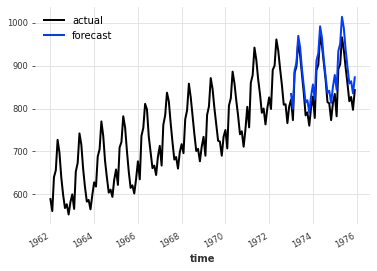
为了考虑这一事实并获得更好的性能,我们可以选择
将时间序列转换为表示每个月的日均牛奶产量(而不是每月的总产量)
进行预测
反转变换
让我们看看如何使用 InvertibleMapper 和 pd.timestamp.days_in_month 实现这一点
(想法来源于 “预测:原理与实践”,作者:Hyndman 和 Athanasopoulos)
为了变换时间序列,我们必须将一个月度值(数据点)除以该值对应时间戳所在月份的天数。
map()(以及 Mapper / InvertibleMapper)通过允许应用一个变换函数使得这一点很方便,该函数使用值及其时间戳来计算新值:f(timestamp, value) = new_value
[11]:
# Transform the time series
toDailyAverage = InvertibleMapper(
fn=lambda timestamp, x: x / timestamp.days_in_month,
inverse_fn=lambda timestamp, x: x * timestamp.days_in_month,
)
dailyAverage = toDailyAverage.transform(series)
dailyAverage.plot()
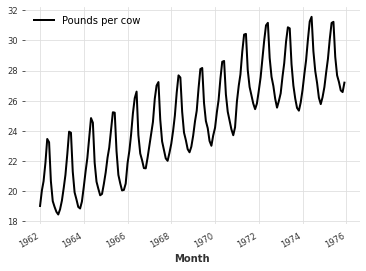
[12]:
# Make a forecast
dailyavg_train, dailyavg_val = dailyAverage.split_after(pd.Timestamp("1973-01-01"))
model = ExponentialSmoothing()
model.fit(dailyavg_train)
dailyavg_forecast = model.predict(36)
plt.title(f"MAPE = {mape(dailyavg_forecast, dailyavg_val):.2f}%")
dailyAverage.plot()
dailyavg_forecast.plot()
plt.legend()
[12]:
<matplotlib.legend.Legend at 0x7ff5e3dd1ac0>

[13]:
# Inverse the transformation
# Here the forecast is stochastic; so we take the median value
forecast = toDailyAverage.inverse_transform(dailyavg_forecast)
[14]:
plt.title(f"MAPE = {mape(forecast, validation):.2f}%")
series.plot(label="actual")
forecast.plot(label="forecast")
plt.legend()
[14]:
<matplotlib.legend.Legend at 0x7ff5e3fbb280>

链式变换:引入 Pipeline¶
现在假设我们既想应用上述变换(日均化),又想将数据集重缩放到 0 到 1 之间以便使用基于神经网络的预测模型。与其分别应用这两个变换,然后再分别反转它们,我们可以使用一个 Pipeline。
[15]:
pipeline = Pipeline([toDailyAverage, scaler])
transformed = pipeline.fit_transform(training)
transformed.plot()

如果流水线中的所有变换都是可逆的,那么 Pipeline 对象也是可逆的。
[16]:
back = pipeline.inverse_transform(transformed)
back.plot()
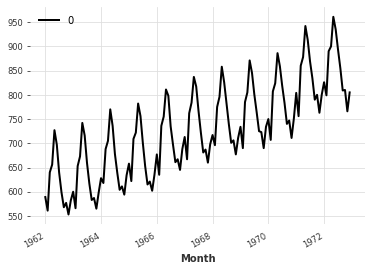
现在回想一下来自 monthly-milk-incomplete.csv 的不完整序列。假设我们想将所有预处理步骤封装到一个 Pipeline 中,包括:一个用于填充缺失值的 MissingValuesFiller,以及一个用于将数据集缩放到 0 到 1 之间的 Scaler。
[17]:
incomplete_series = MonthlyMilkIncompleteDataset().load()
filler = MissingValuesFiller()
scaler = Scaler()
pipeline = Pipeline([filler, scaler])
transformed = pipeline.fit_transform(incomplete_series)
假设我们已经训练了一个神经网络并生成了一些预测。现在,我们想将数据缩放回去。不幸的是,由于 MissingValuesFiller 不是一个 InvertibleDataTransformer(谁会想在结果中插入缺失值呢?!),反向变换将引发一个异常:ValueError: Not all transformers in the pipeline can perform inverse_transform。
令人沮丧吧?幸运的是,您不必从头开始重新运行所有内容,将 MissingValuesFiller 从 Pipeline 中排除。相反,您只需将 inverse_transform 方法的 partial 参数设置为 True。在这种情况下,反向变换将跳过不可逆的转换器来执行。
[18]:
back = pipeline.inverse_transform(transformed, partial=True)
处理多个 TimeSeries¶
通常,我们需要处理多个时间序列。DARTS 支持将 TimeSeries 序列作为转换器和流水线的输入,这样您就不必单独处理每个样本。此外,它会负责存储在变换不同时间序列时(例如,使用缩放器)每个缩放器使用的参数。
[19]:
series = MonthlyMilkDataset().load()
incomplete_series = MonthlyMilkIncompleteDataset().load()
multiple_ts = [incomplete_series, series[:10]]
filler = MissingValuesFiller()
scaler = Scaler()
pipeline = Pipeline([filler, scaler])
transformed = pipeline.fit_transform(multiple_ts)
for ts in transformed:
ts.plot()

[20]:
back = pipeline.inverse_transform(transformed, partial=True)
for ts in back:
ts.plot()
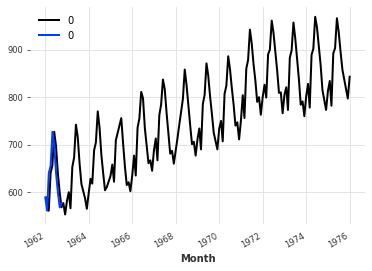
监控和并行处理数据¶
有时,我们可能还需要处理巨大的数据集。在这种情况下,按顺序处理每个样本可能需要相当长的时间。Darts 可以帮助监控变换,并在可能的情况下并行处理多个样本。
在每个转换器或流水线中设置 verbose 参数时,将创建一些进度条
[21]:
series = MonthlyMilkIncompleteDataset().load()
huge_number_of_series = [series] * 10000
scaler = Scaler(verbose=True, name="Basic")
transformed = scaler.fit_transform(huge_number_of_series)
现在我们知道需要等待多久了。但是,由于没有人喜欢浪费时间等待,我们可以利用机器的多个核心并行处理数据。我们可以通过设置 n_jobs 参数来实现(用法与 sklearn 中相同)。
注意:加速效果与可用核心数量和变换的“CPU密集度”密切相关。
[22]:
# setting n_jobs to -1 will make the library using all the cores available in the machine
scaler = Scaler(verbose=True, n_jobs=-1, name="Faster")
scaler.fit(huge_number_of_series)
back = scaler.transform(huge_number_of_series)
[ ]: